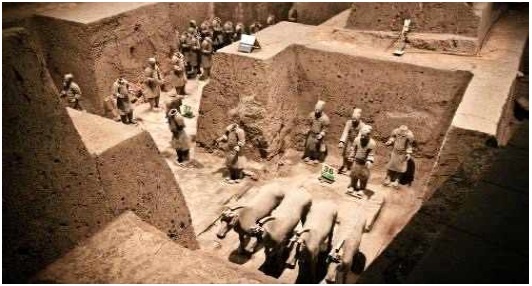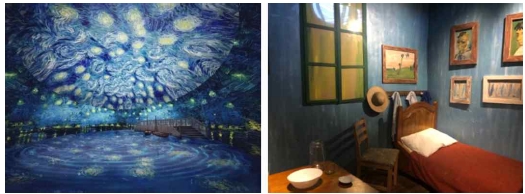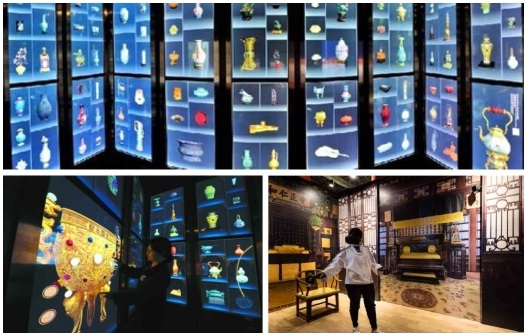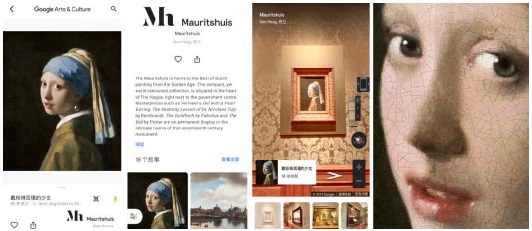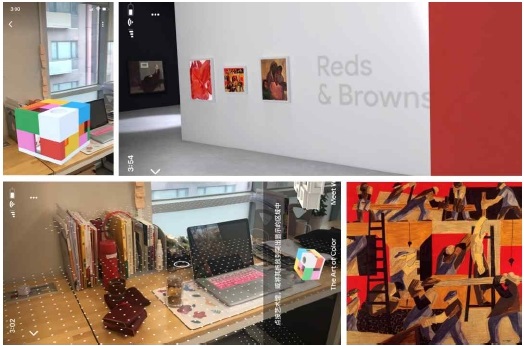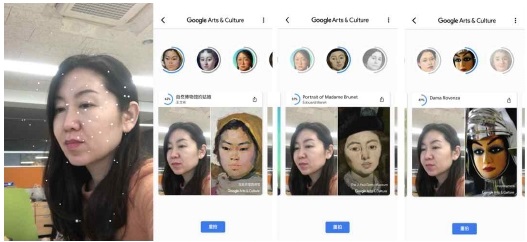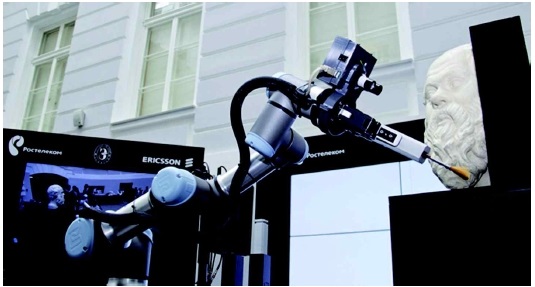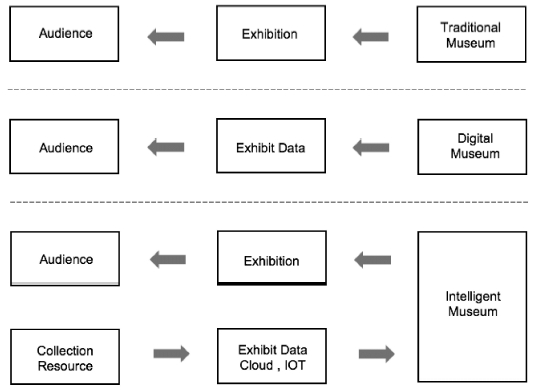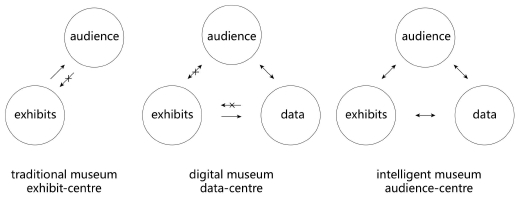
A Comparative Study of Exhibits Information Transmission at Museum based on Different wireless communication technologies
Copyright ⓒ 2020 The Digital Contents Society
This is an Open Access article distributed under the terms of the Creative Commons Attribution Non-CommercialLicense(http://creativecommons.org/licenses/by-nc/3.0/) which permits unrestricted non-commercial use, distribution, and reproduction in any medium, provided the original work is properly cited.

Abstract
The core value of the museum is "objects", but the intelligentization of the museum cannot be achieved without audience. It is worth thinking about how museums can use new technologies to bring out their "education, research, appreciation" functions. This study analyzes the core technologies, exhibition forms, and audience experience of traditional museums, digital museums, and 5G intelligent museums, and explains the progressive relationship between the three types of museums. The exhibition form of the museum exhibition under the influence of 3G, 4G and 5G wireless communication technologies is compared. Through the qualitative analysis method, combined with the current status of the museum, the application layer, physical layer, and data layer of the museum exhibition are proposed under the application mode of 5G wireless communication technology. The research has a certain enlightening significance for improving the information communication between cultural relics and audiences.
초록
박물관의 핵심 가치는 '문물' 이지만, 박물관의 지능화 실현은 인간의 몫이다. 박물관이 새로운 기술을 어떻게 활용할지, 그 '교육, 연구, 감상'의 기능을 발휘할 수 있을지는 생각해 볼 가치가 있다. 본 연구에서는 전통 박물관, 디지털 박물관과 5G 스마트 박물관의 핵심 기술, 전시 형식과 관람객 체험을 분석하여 세 가지 유형의 박물관 사이의 점차적으로 발전한 관계를 설명하였다. 박물관 전시가 3G, 4G 와 5G 무선통신 기술의 영향 하에 전시된 형식을 비교하였으며, 정적인 분석 방법을 통해 박물관 현황을 결합하여 5G 무선통신 기술의 응용 모델에서 박물관 전시가 가능한 응용층, 물리층, 데이터 층을 제시했다. 이렇게 하면 전시의 효과를 크게 높이고 이론과 응용 측면에서 '스마트 박물관' 시스템을 그려볼 수 있다.이 연구는 문화재와 관객 간의 정보 교류를 높이는 데 계발의의가 있다.
Keywords:
Museum, Information communication, Audience experience, Wireless communication technology키워드:
박물관, 전시품, 정보 교환, 관람객 체험, 무선통신 기술Ⅰ. Introduction
The information conveyed by traditional museum exhibition is usually static, trivial and piled up. In early museum exhibitions, organizers liked to arrange and display exhibits in chronological order or place exhibit similar in content or style next to one another.[1] Restricted by time and space, dissemination of information about exhibitions at museums mostly focuses on exhibits, from which the audience gets incomplete fragmented information about exhibits. Such a form of display in traditional museums makes the audience feel museum fatigue.[2] With the advancement of the times and the continuous iterative development of science and technology, Audience to museums are not just content with appreciation of exhibits, but hope to know more detailed true information about exhibits in multiple dimensions, as well as deconstruct historical time and space and artistic value through exhibits. Therefore, the form of information dissemination at traditional museums cannot meet the needs of development in this era.
John H. Falk’s study of the audience of museums and satisfaction with their identity shows that their selection and enjoyment of the museum experience are based on their perception of thinking about and reinforcing self-concept.[3] With digital information transmission technology, modern museums break spatiotemporal restrictions on dissemination of information about exhibits, help the audience to greatly improve their perception, and make it possible to make up for deficiency in dissemination of information about exhibits at traditional museums. Compared with the application of 2G, 3G and 4G wireless communication technologies in dissemination of information about exhibits at museums, the 5G wireless communication technology makes the possibility feasible. In particular, the application of XR communication technology from 5G wireless communication technology can not only break the spatiotemporal restrictions on information about exhibits to change the cognitive experience of the audience, but also enable us to interpret exhibits more precisely to promote the fusion of exhibitions and the audience and dissemination of exhibitions.[4]
Ⅱ. Forms of Information at museums
2-1 Information transfer based on 2G and 3G wireless communication technology
Exhibitions are a medium through which museums communicate with the audience. Before the mid 20th century, museums attached importance to “collection” and “research”. After the1970s, they gradually began to stress how to communicate with the audience, especially the narration and interaction of display and exhibitions. At that time, however, the information interaction between exhibits and the audience at museums still centered on exhibits with only a little information, so the audience had to acquire information about exhibits at the physical level.
In 1990, Table 1 has shown 1G wireless communication technology was replaced by 2G wireless communication technology which provided rich set of services such as high voice quality and global mobility based on the digital radio signal technology, which as a digital wireless communication technology better served customers providing a new way to transfer information about exhibits at museums.[5] For example, when entering Emperor Qinshihuang’s Mausoleum in Xi’an of China, visitors will see a huge pit, including Pit No. 1, No. 2 and No. 3, beside which are tour routes for them to walk along, but as exhibits are faraway from them, they have to take pictures of them with cameras and then appreciate their details on camera screens by zooming in and taking a close look. See Figure 1.
2-2 Information transfer based on 4G wireless communication technology at traditional museum
The 4G wireless communication technology enabled features of mobile phones, MP3, cameras and mobile broadband services to be implemented on one device.[6] The forms of exhibitions were diversified, digital exhibition format is widely used as a supplement to traditional museums, and museums began to lay emphasis on the experience of the audience at exhibitions. If we say traditional museology focuses on the management and semiotic expression of museums, Table 2 has shown the core of new museology is interaction between museums and society.[7]
Since 2010, the 4G wireless communication technology has been developed, especially in the combination of technical equipment and the 4G wireless communication technology, and exhibition sat museums have also been upgraded. Once the user reaches the museum, he uses the local network of museum (Wi-Fi) to listen to the streaming guided tour of museum explaining the different artifacts. In terms of forms of exhibitions, exhibits are combined with LED screens, projection and animations to create an atmosphere of light and shadow, realizing virtual interaction with the audience by virtue of VR, AR and MR.
Digital exhibitions covered virtual exhibitions. Exhibitions are redefined by digital science and technology. What we commonly see is the “online” and “virtual” display of “physical museums and exhibits” through 3D scanning.[8] Another type is real virtual museums, which have not a physical entity. For instance, the Immersed Experience of Van Gogh Exhibition at National Museum of China applied a brand new 360° panoramic and holographic video image technology, while adding a VR experience exhibition zone and an immersed exhibition zone. VR reproduced Vincent Van Gogh’s works and the places where he created them in a stereoscopic way. (see Figure 2) The audience could bring their VR devices to visit the places where paintings were created. In a narrative style, the exhibition enabled the audience to experience how he created these works in person. When the audience experienced the process, sometimes there was suspension due to the time-delay and bandwidth limitation of 4G wireless communication technology. The form of exhibitions focuses on the experience of the audience.
On December 22, 2015, the Palace Museum became the first in the world to use a whole ancient wooden structure as a digital exhibition hall with its pilot launch of “The Palace Museum Digital Gallery at the Gate of Correct Deportment”. There are two parts of exhibitions. As one part, 4 LED screens are used to display the high precision panoramic 3D model of the Palace Museum, in combination with high-definition videos and interactive demonstrations, to provide “a digital tour guide” with a vivid visual“digital 3D map”. The exhibitions enable the audience to walk “above” the Forbidden City, learn about different spatial locations and historical periods of the Imperial Palace through the digital gate, and get a panoramic description from the Forbidden City to the Palace Museum. The other part is the digital interaction zone of “Palace Museum Collections” for seamless interaction with the audience in digital forms. See Figure 3.
Digital museums are using digital information technology, Internet technology and computing-related science and technology to digitally display to the public in cyberspace all the information and content of all the collections contained in realistic museums, which not only enriches the museum's functions but also expands The scope of its application space.[9]
On Google Arts & Culture, Figure 4 has shown the Zoom Views mode, the audience can see microscopic details such as hair, cracks and splashed ink spots that are nearly invisible to human eyes. These pictures can be clicked and magnified tens of and hundreds of times. Though Zoom Views cannot bring a “holistic sense” of artworks and exhibition space to users like VR tours and offline visits, it makes up for the insufficient experience of details at physical museums.
For example, to attend exhibitions of survived genuine works of Vermeer, a master painter in the Dutch Golden Age, in more than 10 cities of 7 countries such as New York, Paris, London, The Hague, and Washington around the world, it not only takes time and money but also is impractical for the audience. In the “Google Art Project”, Mauritshuis in The Hague which collects Vermeer’s painting Girl with a Pearl Earring most renowned in the world has cooperated with “ Google Arts & Culture” to launch a virtual museum that can display the existing 36 works of Vermeer. Since launched in February 2011.[10] The project has gathered works of the same artists that scattered in several museums in an online virtual space through online AR exhibitions, bringing a visual feast of highly intensive artworks of the same schools to the audience. See Figure 5.and Figure 6.
Another feature of “Google Arts & Culture” launched in January 2018 is “Is your portrait in a museum?” based on AI technology, which can arouse memories and associations between the audience of online museums and artworks. When a user uploads a selfie, “Google Arts & Culture” can find 5 portraits that look like the user. Harry Lorayne, a famous expert in mnemonics, said that the basic rule of memory is to associate new information with things already known. As for associations and matching between an object in paintings and a story behind it, participation of users in sorting out tags of paintings and improvement of smart searching, the audience can automatically classify and store artworks according to parameters and stories in their minds with mnemonics of associations by similarity and subordination, so as to form cultural memories. Searching artworks resembling themselves creates a close “genetic relationship” between artworks and the audience originally separated by a wide gap of history. Through such image associations, the audience can be motivated to explore their relationships with artworks actively rather than accept dull knowledge information passively, thus tracing historical backgrounds of works. See Figure 7.
You Yang, director of the UCCA Center for Contemporary Arts, He believes that the way in which each exhibit is displayed is part of the work itself, so not all works are suitable for display on the Internet. It is impossible for digital virtual exhibitions to replace real museums. Digital technology is a kind of simulation, in which the display is no longer the real objects, digital technology can not replace the reality.[11]
2-3 Information transfer based on 5G wireless communication technology
The performance features of 5G wireless communication technology are high data speed, reduced delay, lower energy consumption, lower costs, improved system capacity and large-scale equipment connection. A reliable 5G wireless communication technology will help XR applications develop to a new level, and “XR (Extended Reality) is the integration of many visual interaction technologies familiar to us such as Virtual Reality (VR), Augmented Reality(AR) and Mixed Reality (MR), to realize the ‘immersed’ experience of the virtual and real worlds switched seamlessly”.[12]
Figure 8 has shown the State Hermitage in Saint Petersburg of Russia is one of the largest art museums in the world, where a pilot 5G network has been implemented.[13] Two cases of applying 5G in combination with VR, haptic technology and robotic technology. For example, an artwork was restored with the help of a remote control robotic arm. The high bit rate and low delay of 5G enable artists with rare expertise to carry out precision restoration around the world. In the other case of application, partners showed the potential of 5G in distance learning. As a part, a master of fine art demonstrated the precision technology of using a remote control robotic arm to restore an artwork. In both of the demonstrations, 4K live streaming transmitted to VR glasses was employed to create a sense of presence for teachers and students.
2-4 A comparison of forms and features of exhibitions among museums based on different communication technology
As a medium, the museum is different from the common paper media, sound media, and movie media in terms of communication process, methods, and characteristics. It mainly focuses on core technologies, exhibit forms, communication form, audience acceptance and audience experience methods.
Under the support of different wireless technology communication platforms, museum exhibitions have found that the available exhibition equipment, exhibition expressions, and the experience that audience get in the process have all changed greatly.
5G wireless communication technology, the form of museum exhibition tends to be intelligent, and can connect more high-tech products, as well as the intelligent application of cloud platform and big data. The experience is even richer. See Table 3.
Ⅲ. Three types of museums
3-1 Definitions of the three types of museums
According to forms of exhibitions, museums can be divided into traditional museum, digital museum and intelligent museum. “From the perspective of information flow, information interaction between the audience and exhibits at traditional museums is basically ‘from objects to people’, while interaction ‘from people to objects’ can be hardly implemented”.[14] Digital museums are virtual museums based on information technology, which implement such functions as storage of collections, display, scientific research and social education.[15] Intelligent museums transform a static dualistic model to a dynamic pluralistic model of delivering information about exhibits, to realize connectivity among people, objects and data.
3-2 A comparison of interface among the three types of museums
Exhibition at traditional museums focus on exhibits, basically in a way of information interaction “from objects to people” between the audience and objects, where the way of interaction “from people to objects” can be hardly implemented. The core business of Traditional museum needs to be carried out on the premise of actual contact between people and exhibits. Sometimes, to protect cultural relics, it is common that there is a severe shortage of information about them and no chance for many collections to be exhibited. Traditional museums are restricted to a large extent by time, space and forms of exhibitions.
Exhibition at digital museums stress the way of information interaction among objects, data and people by transforming physical collections into digital information. With “data” at its core, digital museums first transform collections and relevant information at museums into “data”, which is then shown visually to the audience with technologies of network transmission and digital display. They realize two-way information interaction “between data and people”, but information transfer “from objects to data” is still unidirectional, so they are still a unidirectional way of information interaction.
The emergence of 5G intelligent museums have changed the way of information transfer at museums fundamentally, connecting the two-way information interaction channels among “objects, data and people”of digital museums, realizing the development of traditional museums from digital to intelligent museums. From the dualistic relationship “between objects and people”, to the static unidirectional dualistic relationship “from objects to data and then to people”, and then to the dynamic two-way pluralistic relationship “among objects, people and data”, “people” are placed at the core of intelligent museums again. Under the platform of 5G wireless communication technology, before exhibits are exhibited, data collection and analysis are firstly carried out to convey exhibit information to the audience through more diversified display means. See Figure 9.
3-3 Relationships among the three types of museums
Looking at traditional museums and digital museums as a whole, digital museums are digital models built by traditional museums through digitization. This model consists of massive data and a series of software systems. But this model is static but hardly considers the impact of software objects on the data model.
There are obvious contrasts in advantages and disadvantages between traditional museum and digital plane or 3D display of cultural relics. The former can bring a sense of reality to the audience in terms of physical movements, spatial relationships between exhibits and exhibition halls, and texture of exhibits, which the latter does not possess. Tools and means adopted should vary with the change of contexts, so activities applicable to the virtual world may not be feasible in the real world.[16] Digital museums are a supplement to the content and form of exhibitions at traditional museum, rather than a replacement. Digital museum are a part of the development of traditional museum.
5G intelligent museums are developed from traditional museums. 5G wireless communication technology combined with such high-tech means as big data, cloud platforms and IOT are forms of multi-dimensional information interaction adopted by 5G intelligent museums. By creating a way of information interaction “between people and objects”, “between objects”, and “between people”, effective transfer of information by museums can be achieved.
5G intelligent museums can realize a more comprehensive collection of information and richer expressions of information, and need the support of digitalized traditional museums. The way of information organization of the two types of museums based on associated data is also a future direction of development of intelligent museums.
The early development of digital museums was mainly influenced by digital libraries, emphasizing the main content of digitizing collection resources.[17] Digitization, networking and intelligence are recognized as the general trend of future social development. The intelligent Museum is a new type of museum based on a digital museum, relying on the high-speed bandwidth of 5G wireless communication technology, and making full use of new technologies such as the IOT and cloud computing. See Figure 10.
Ⅳ. 5G intelligent museums
4-1 5G wireless communication technology
The fifth generation wireless communication technology (5th generation mobile networks or 5th generation wireless systems, referred to as 5G) is the latest generation of cellular mobile communication technology, which is an extension of 4G (LTE-A, WiMAX-A) systems. Figure 11 has shown 5G performance goals were high data rates, reduced latency, energy savings, reduced costs, increased system capacity, and large-scale device connectivity.[18]
4-2 The information architecture of 5G intelligent museums
As Kenneth Hudson, a famous museum researcher and media worker, described, a tiger in a museum is no longer a common tiger but a museum tiger, which should be no more or less than it.
In the mode of applying 5G wireless communication technology, information transfer at physical, data and sensing layers of exhibitions at museums can greatly increase the possibility that display information about collections is close to the original appearance of the exhibit itself, as well as improve the applicability of cloud platforms, IOT and big data in exhibitions at museums.
In the past 30 years, museums have not only focused on the physical structures and functions of exhibits, but also paid more and more attention to the “associative” and “recording” information about exhibits. Objects in museums exist in various connections.[19] Terminals and IOT based on 5G wireless communication technology, for museums, mean that various articles used in daily life in museums can be networked and that you can control them efficiently and easily when deconstructing museums. Data information bases can expand the content of an exhibit in many ways, such as starting from the perspective of a designer, digging up stories behind collectors and collections, discussing the historical background of the exhibit, describing content in a more poetic and literary way, or talking about ideas of the audience, etc. See Figure 12.
In society today, exhibitions at museums imply a fundamental change, that is, it is believed that museums no longer represent an absolute authority in this field and even the ordinary audience can choose opinions they prefer.[20] 5G intelligent museums consist of a physical layer (a major data source), a sensing layer (data acquisition), a communication layer (data transmission), a data layer (integration and processing of data) etc., to finally implement such basic features as information intelligence.
Hubei Provincial Museum cooperates with China Mobile Hubei and Huawei to create a "5G intelligent Museum" in China. In two months, the 3D data collection of all cultural relics was completed, and the characteristics of large bandwidth, low latency, and ultra-multi-connection of 5G connections were fully utilized, combined with other advanced technologies, and the museum truly ushered in the era of 5G intelligent.
The case of Hitting an exhibition at the State Hermitage in Russia show off the future of 5G wireless communication technology and VR.[21] In the context show off the future of 5G wireless communication technology and VR. In the context of the 5G communication platform, the application of high-tech equipment is smooth, making the museum exhibition more intelligent, allowing the audience to change from a "visitor" to a historical "participant", so that the exhibition information is Through 5G wireless communication technology effectively transmitted to the audience. See Figure 13.
4-3 The information transmission of 5G intelligent museum
“Objects” in museums contain structural, functional, associative and recording information. They emphasize a comprehensive interpretation of information about exhibits, try to convey the whole context of exhibits to the audience, and realize the all-dimensional restoration of information about exhibits. the value of cultural relics depends on the information they contain, and exhibitions at museums can be seen as a process of conveying information.
Information of museums is divided into three levels, namely natural physical attribute information, functional information, and information associated with something else, which represent certain stages of the occurrence and development of “objects” in museums respectively. If “objects” in museums are revealed from different perspectives, “recording” information about different stages of collections is closer to information really needed by museums.[22]
The famous master of communication in the 20th century, McLuhan, in his classic work "Understanding the Media", elicited the famous "media is information" judgment, and affirmed the core position of information in the development of contemporary media. The intelligent museum is an intelligent application system of services and museums that is based on modern technology and takes audience needs as the center. Through this system, the audience can get a richer and more interesting viewing experience; the museum can also get the audience's information feedback in the first time.
The Hubei Museum of China not only achieved full coverage of 5G wireless communication technology, but also equipped with a 360-degree panoramic camera. Viewers can use 5G wireless communication technology to control the direction of the camera with a mobile phone to achieve high-definition viewing of cultural relics. The audience hit the volley bell hammer, followed by a special induction device to follow the bell displayed on the LED display to follow the stroke, and issued a corresponding music sound. In the APP display area, viewers can operate mobile phones to experience three viewing modes. Tourists on the site only need to take pictures with their mobile phones, and the cultural relics can automatically identify and display relevant information. For visitors who are not present, they can also use a 360-degree panoramic screen. Immersive visit to the museum. See Figure 14.
In the VR interactive experience area, audience can wear VR glasses and hold VR terminals to interact with cultural relics at close range. The museum also prepares a pocket museum relic card for visitors, with exquisite high-resolution cultural relic pictures printed on the front and back, and you can use the AR navigation function of the app to learn the story behind the relics.
V. conclusion
The museum system uses the direct information interaction between "people" and "things" as a means to achieve the collection, protection, research, dissemination and display of physical and human physical evidence pairs in real space.
Information intelligence is to establish a highly interactive relationship between the audience and the museum's exhibits, and to use data and technology to provide ubiquitous services to audiences based on "people's needs."
The main purpose of the museum's information intelligence is to focus on the needs of the audience and to show the audience different levels of high-fidelity information about the exhibits. By installing IOT infrastructure that may involve sensors internally, museums can sense what viewers want to know. Restore the information about the exhibits to the greatest extent to bring them closer to the audience's mental model; immediately provide knowledge links to cultural relics and basic information such as service facilities. In the exhibition, prominent information about exhibits and audiences will be in the same space-time environment, and the relationship “at the same time and place” will become the basis for information dissemination.
In order to break the limitation of time and space brought by direct information interaction, digital museums featuring digital collection and processing of museums and collections and virtual display actually act as a bridge between people and exhibits. Museum staff communicated with audience via the official website and email, improved the exhibition, and audience viewed the museum’s news and collection information.[23] However, although "digital" Formally increases the audience’s freedom, but hinders the direct channel of interaction between “people” and “object”. 5G intelligent Museum provides mobile access under the network environment provided by the Internet. Based on the digital resources and virtualized display of digital museums, it realizes timely, efficient and accurate delivery of exhibit information through big data, cloud computing, and MR, further enhancing the museum Communication between the exhibition and the audience.
When we go beyond exhibitions, beyond museum services, to the museum's information architecture to the level, we will find that 5G intelligent museum have narrowed the distance between exhibits and audiences. Reviewing the application process of 5G intelligent museum, it integrates the processes of museum perception, information transmission, and information acquisition, which implies the interaction between audience and museum information, although not perfect. With the widespread application of 5G wireless communication technology, intelligent museum and audience will gain more contact in the transfer of exhibit information, making the exhibits more accurate information for the audience during the exhibition.
With the advancement of technology, relying on 5G wireless communication technology to carry big data, cloud platforms, and the IOT will increase the possibility of exhibition innovation opportunities. Smart museum exhibitions will also provide audience with more personalized information services, allowing more people to enter the museum and experience more intelligent exhibition information services.
Acknowledgments
This paper has been conducted with the support of the “Design Engineering Postgraduate Schools” program, a R&D project initiated by the Ministry of Trade, Industry and Energy of the Republic of Korea. (N0001436)
References
- Geng chao, Liu di, Lu qingsong, Peng zhicai and Lu xin, The Theory and Practice of Museology, Science of China Press, 2018.
- Greenhill, Eileen Hooper, Museums and the Shaping of Knowledge, Routledge, 1992.
-
Falk, John H, Identity and the Museum Visitor Experience, Routledge, 2016.
[https://doi.org/10.4324/9781315427058]

- Perfecto C, Elbamby M S, Park, Mobile XR over 5G: A way forward with mmWaves and Edge. arXiv preprint arXiv: 1905.04599, , 2019.
- Fagbohun, O, “Comparative Studies on 3G, 4G and 5G Wireless Technology,” IOSR Journal of Electronics and Communication Engineering, 9(3), pp. 88-94, 2014.
- Gupta, Piyush, and Priyadarshan Patil, “4G-A New Era in Wireless Telecommunication,” Magister Program in S/W Engineering, Malardalen University, 2009.
- Zhen shuonan, Collection of Museum Studies of Zhen shuonan, Encyclopedia of China Press, 2004.
- Schweibenz, W, “The Development of Virtual Museums,” The Journal of Virtual museums, ICOM News Magazine, 3, 3, 2004.
- Wang yujuan, “Talking about the Concept, Characteristics and Development Model of Digital Museum,” The Journey of Chinese Culture Expo, 31, pp. 51-52, 2016.
- Google Arts & Culture [Internet]. Available:https://artsandculture.google.com/
-
Jin-Ok Park, “Subjectivity study on the From of the Virtual Reality Contents User Experience,” The journal of Digital Contents Society, Vol, 20, No. 2, PP. 395-403, 2019.
[https://doi.org/10.9728/dcs.2019.20.2.395]

- Chu leyang, Chen weidong, Tan yue and Zheng sisi, “Rebuliding the Experience: Extended Reality(XR) Technology and its Education Application Outlook,” The journal of distance education, 37(1), pp. 17-31, 2019.
- 5G at the Hermitage Museum [Internet]. Available:https://www.ericsson.com/en/news/2017/11/5g-at-the-hermitage-museum
- Feng songlin, Wang yi, Yang xiaofei, Intelligent Museum Cases, Cultural relics press of China, 2017.
- Jin Xue, “Analysis of the development of digital museums,” The journal of Science and wealth, 6, pp.304-304, 2011.
- Nina Simon, Entering an Era of Museum 2.0, Zhejiang University Press, 2018.
- Chen Gang, “Wisdom Museum——New Development Trend of Digital Museum,” The Journal of China Museum, 4, pp. 2-9, 2013.
- 5G[Internet]. Available: https://zh.wikipedia.org/wiki/5G
- An Laishun, Talking about the information collection and sharing of contemporary museums, The Journal of Chinese Museum, 1, pp. 20-24, 2012.
- Lord, Gail Dexter, and Barry Lord. The manual of museum management, Rowman Altamira, 2009.
- An exhibition at the State Hermitage Museum in Russia shows off the future of 5G and VR [Internet].Available: https://feedmagazine.tv/tech-feed/vr/haptics-at-the-hermitage
- Jeffrey, Lewis, Zhang Jinping, “The Handling of Museum Collections and the International Association of Museums, Code of Ethics for Museums,” The Journal of China Museum of Communications, 5, pp. 26-26, 2003.
-
Jongwook Lee, “Study on Cultural Heritage Education through Authoring of Virtual Museum,” The journal of Digital Contents Society, Vol, 20, No. 10, PP. 1979-1986, 2019.
[https://doi.org/10.9728/dcs.2019.20.10.1979]


2001년 : 지린 에술 대학교 (문학 학사)
2010년 : 청화 대학교 (에술 석사)
2018년~현 재: 국민대학교 테크노디자인전문대학원 스마트경험디자인학과 박사과정
2001년~2003년: 중국 법률 출판사 미술 편집
2003년~2016년: 북곙평준천지문화발전센터 설계부 주임
2016년~2017년: 중탕과기회사 대외상무부 주임
※관심분야: 서비스디자인(Service Design), 박물관 연구

1999년 : KAIST 인간공학 박사
1993년 : KAIST 인간공학 석사
1991년 : KAIST 전기전자공학 학사
국민대학교 테크노디자인전문대학원 스마트경험디자인학과 주임교수
삼성전자 DTV UX 책임 연구원
삼성전자 전사 사용성 인증 위원
팬택&큐리텔 UI 팀장 및 팬택 계열 해외 UI 팀장
중국 칭화대학교 방문교수
사단법인 대한사용자경험전문가협회 협회장
사단법인 한국서비스디자인학회 학회장
※관심분야: 인터랙션디자인(Interaction Design), 서비스디자인(Service Design), 도시UX(City UX)

